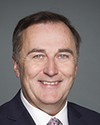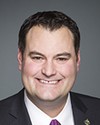As was mentioned, I'm here on behalf of the commander of the Canadian Army, Lieutenant-General Wynnyk.
Lieutenant-General Wynnyk is the champion for indigenous peoples. In his role in the Canadian Armed Forces and the Department of National Defence, he encourages indigenous peoples to consider pursuing a career with the department and the Canadian Armed Forces, or the CAF.
In order to achieve his mandate, the Commander of the Canadian Army invests himself in the employment equity cause, by fostering a representative and equitable workforce and a welcoming workplace for indigenous peoples. He contributes to the corporate culture change and promotes different indigenous programs offered by the Department of National Defence, or DND, and the CAF. To help him with his mandate, our commander is supported by an aboriginal advisory group. Two of those advisers are present with us today.
We noted the indigenous culture within the Canadian Armed Forces. To achieve our indigenous representation target of 3.5%, we are actively engaging indigenous communities where we know the population is much younger than the national average. In the context of an aging population, you have to keep in mind that for operational purposes this is extremely important for us.
Furthermore, we have developed over the last few years numerous training programs for our personnel. There are five different programs that were specifically created for the indigenous population of Canada. Our oldest program is the Canadian Forces aboriginal entry program, introduced in 1997. This is a pre-enrolment program that provides a limited experience of military service to the participants. It is essentially a pre-recruit training course that includes military training, physical fitness training, and career guidance. If successful, the candidates, the graduates, are offered the opportunity to enrol in the Canadian Armed Forces. This program is offered three times a year. Two serials are conducted in Saint-Jean, Quebec, and there's an additional one conducted at the naval fleet school in Halifax.
The second program is the aboriginal leadership opportunity year, known as ALOY.
we refer to it as the ALOY.
The ALOY was first offered in 2008 at the Royal Military College of Canada, in Kingston, Ontario. Participants are enrolled for one year as officer cadets and given a highly positive educational and leadership experience. The program is based on four pillars: academics, military, physical fitness, and culture. At the end of the year, ALOY officer cadets are granted the equivalent to basic military officer qualification and they may apply to continue at the college.
The Canadian Armed Forces have also implemented three summer programs at the end of which young indigenous people may join the army or the navy primary reserve. These programs are offered in the east, the west, and on the Pacific coast.
The first one and probably the most well known is Bold Eagle. It is designed for indigenous youth from western Canada and was first conducted in 1989. This course is offered every summer at Canadian Forces Base Wainwright in Alberta. The second summer program we offer was first conducted in 2003, and it is led by the Royal Canadian Navy. Named Raven, it is offered every year at the Naval Fleet School Pacific, in Esquimalt, British Columbia. The third summer program we have is named Black Bear. It was first conducted in 2009. This program is led by the Canadian Army, and it's being delivered every year during the summer at Canadian Forces Base Gagetown in New Brunswick.
We have had so much success over the last few years with these three programs that the Canadian Army is planning on creating two new, similar programs in Quebec and Ontario. We're aiming at starting in 2019.
Now I'm going to talk a little more personally at this point.
Over the last 30 years, I've seen a lot of positive change in terms of indigenous cultural awareness within the Canadian Armed Forces and the department.
We can certainly look at indigenous communities as a pool of recruits, but they have so much more to offer, in terms of their potential and contribution.
Against the backdrop of an aging population, I see indigenous communities as a pool of recruits that the Canadian Armed Forces cannot ignore, especially given the serious economic and social challenges many communities face, remote ones in particular. To my mind, it is an extremely beneficial union, both for candidates and these young men and women.
When I am addressing the new graduates on any indigenous program, I always like to talk about how they will grow personally but also professionally by joining our institution. The personal, leadership, and technical skills they will be acquiring will enhance their communities when they go back to them.
The other idea I like to convey all the time is that when you join the Canadian Armed Forces you're gaining two extended families. Personally, I'm very closely tied to my family back on the reserve, but I do see that as a great opportunity to have the second family, the Royal 22nd Regiment family, the army family, the CAF family, that I can relate to. I can always tap into both, depending on my personal needs. Actually, I would offer to you that after close to 30 years of service, half my friends are the people back in the community and the other half are the people back in the CAF. It has been a privilege to serve in uniform.
For all of us here at the table, every single time we go to Saint-Jean or to Wainwright to address these young men and women who are going through these summer programs, we always like to give them a bit of encouragement. We like to showcase ourselves as a success story, if I can say that. Very often these young men and women only need that little additional push to join because, let's be honest, to join the CAF is something that can be a bit intimidating.
The other aspect I like very much about our indigenous program as well is the cultural aspect of it. A lot of our youth are struggling with their own personal identity. Who are they? Where do they fit? Many of these young men and women, even some of those who were born and raised on the reserve, do struggle with their personal identity. Built into this program we always have that cultural component.
A lot of our youth can sometimes have a real interaction with an elder, when they are signing up for the first time or when they are undergoing this program. A lot of our communities have been extremely Christianized. My community was Christianized three centuries ago. A lot of our traditional knowledge has disappeared over the last generations so very often our people are first introduced to traditional ideas and concepts when they go through these programs. In that regard, I would like to highlight that our elders are doing a fantastic job.
Another important aspect of this program relates to self-esteem. Earlier, I mentioned social and economic challenges, but challenges also exist around identity. Joining the ranks of the Canadian Armed Forces often helps give youth another view of their indigenous identity. It helps put a much more positive spin, if you will, on a potentially negative view of their identity.
I would also like to highlight for the committee members how diverse indigenous communities are. We hear a lot about how diverse Canada is, as a whole, but one-size-fits-all solutions and policies will not work for aboriginal communities.
Communities in eastern Canada were in contact with the first Europeans to come here more than 300 years ago. Communities in the Arctic met the first Canadians about 75 years ago. Some communities still commonly speak their aboriginal languages, while others have lost their languages completely.
Some communities live in urban settings. My community was in the middle of the forest when the Jesuits founded it some 300 years ago. Quebec City joined us, if you will recall. Communities became settlement-based about a half-century ago, and indigenous peoples started leaving their communities for cities. As you can appreciate, then, our communities are extremely diverse.
I would like to conclude by pointing out that all of the programs in place share the aim of building bridges between indigenous communities and the Canadian Armed Forces, so that indigenous peoples feel encouraged to pursue a career in the CAF.
Guided by the indigenous people in uniform, mentored by our elders, inspired by our ancestors who have always defended this country, and supported by all the members of the Canadian Armed Forces, we hope we can guide and reassure these young men and women who are about to embrace a unique and demanding career.
Thank you for inviting us to appear today. It's much appreciated. We are here to answer any questions you may have. I would like to highlight that any question specific to the ranger program should be directed to Colonel Mackay.
Thank you.




